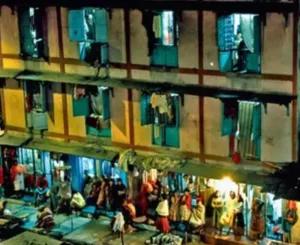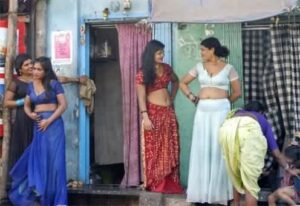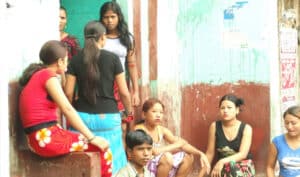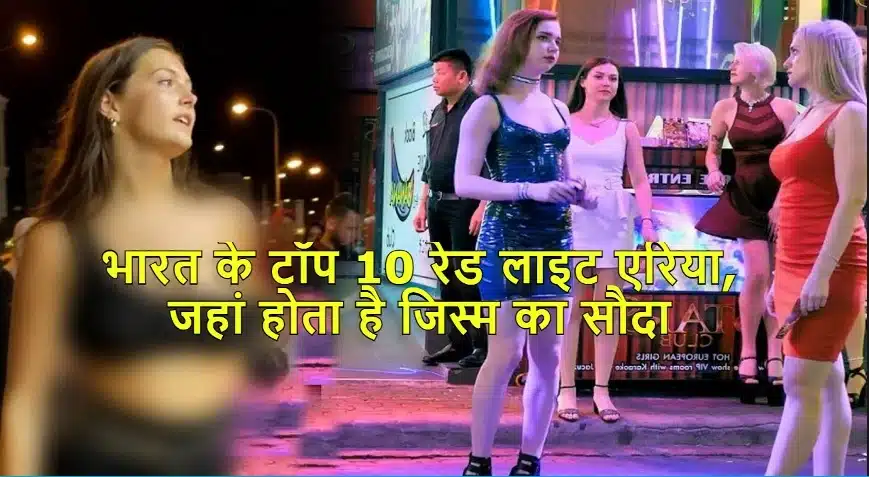India is known for its diverse culture, traditions, and customs, and it’s not surprising that the country has a significant number of red-light areas. These areas are known for commercial sex work, which has been a part of Indian society for centuries. While the legality of sex work is still a contentious issue in India, it is crucial to understand and acknowledge the existence of these areas.
Here are the top 10 exclusive red light areas in India that you must know about:
- G.B Road, Delhi

However, the area is often targeted by police raids, which have led to the arrests of both sex workers and clients. The women who work on G.B Road come from various backgrounds, many of them facing extreme poverty and coming from disadvantaged families. For them, prostitution is the only way to earn a living, but they often experience discrimination and abuse from customers and even the authorities.
2. Kamathipura, Mumbai

Kamathipura is a well-known red-light area in Mumbai and is considered one of the oldest and largest in India. It has a history dating back to the 18th century and is home to over 15,000 sex workers. The area was established by the East India Company, which recruited women from different parts of the country.
Kamathipura has a diverse mix of cultures, with people from Maharashtrian, Tamil, and Kannada backgrounds living there. It is often called “Asia’s largest red light district” and is also known for its vibrant nightlife, which includes bars and dance clubs.
Despite the presence of sex workers, Kamathipura is seen as a place where women can find employment in a relatively safe environment. The area is closely monitored by the police, and the women have access to medical facilities and other social services. The government has also taken steps to reduce the stigma associated with sex work by legalizing it and providing support services to the workers.
3. Pune’s Budhwar Peth
Budhwar Peth in Pune is one of India’s oldest and most well-known red-light areas. It has been a part of the city since the 18th century and is situated in a central location. Budhwar Peth is infamous for its traditional sex trade and is a bustling street with many small rooms that sex workers rent out.
These workers can be seen offering services like massages and other sexual activities along the street, both during the day and at night. The area is also home to shops that sell items related to the sex trade, such as condoms and sex toys. Additionally, there are several brothels and hotels where clients can meet with sex workers.
4. Kotha No. 64, Chennai
Kotha No. 64 in Chennai is considered to be one of the prominent yet oldest red-light areas in India. It was established long ago, in the mid-1800s, when British colonists set it up as a place for their soldiers to find female companionship. Although it was closed down in the 1970s, it reopened in 1989 and has been operating as a red-light area since then.
Even though prostitution is illegal; it still exists in Kotha No. 64. Unfortunately, this red-light district has been in the news for negative reasons. Recent reports have shown an increase in HIV cases among the sex workers here. These women also face exploitation as they don’t have legal rights to protect them.
5. Meghnagar, Madhya Pradesh
Meghnagar, a small town in Madhya Pradesh near Jhabua, has gained notoriety as one of India’s well-known red-light areas. It is home to numerous brothels and sex workers who operate within and around the town. Over time, Meghnagar has become increasingly popular among both tourists and locals, with some considering it to be the most genuine red light area in India.
The sex workers in Meghnagar come from diverse backgrounds, many of whom hail from deprived conditions in countries like Bangladesh and Nepal. Often facing limited education and job opportunities, these women turn to prostitution as a means of earning a livelihood. Despite their challenging circumstances, the sex workers of Meghnagar are seen as resilient and independent individuals who are determined to create a better future for themselves and their families.
6. Falkland Road, Mumbai
Falkland Road, located in Mumbai, is well-known as one of India’s most infamous red-light areas. It is situated in the heart of the city and is home to marginalised and vulnerable sex workers. Many of these women come from rural areas or disadvantaged backgrounds and are often victims of trafficking.
Falkland Road has a distinct culture with various brothels, bars, and other establishments. While sex work is technically legal in India, enforcement is lax in this area, leading to the exploitation and abuse of women. The government has made efforts to address these issues by providing basic healthcare and educational programs to support sex workers.
However, Falkland Road remains a dangerous place, with a high prevalence of HIV/AIDS and other sexually transmitted infections. Many sex workers have limited options for earning a living to support themselves and their families, trapping them in a cycle of poverty and exploitation.
7. Sonagachi, Kolkata

Most of the workers in Sonagachi are victims of trafficking and are forced into the sex industry against their will. There have been cases of underage girls being forced into prostitution as well. These women work in small rooms with limited facilities and face challenges when it comes to sanitation and healthcare. Despite the difficult circumstances, the sex workers in Sonagachi show determination to improve their lives and seek a better future.
8. Reshampura, Gwalior
Reshampura, the red light district in Gwalior, is well-known for its lively and active sex trade. Situated in the heart of Gwalior, this area is home to numerous brothels that serve as the primary source of income for local sex workers. Sadly, women from various parts of India are often deceived and compelled into the sex trade in Gwalior.
Despite being illegal, prostitution continues to be a significant means of earning money for many sex workers in Reshampura. These women face dire poverty and societal stigma, making them susceptible to exploitation by traffickers and pimps. While some organisations strive to support and advocate for these women, their living conditions remain grim.
9. Foras Road, Mumbai
Foras Road, situated in Mumbai’s red-light district, is a popular place for those seeking commercial sex services. It has a long history, being the oldest red-light area in the city, with brothels dating back to the 17th century. The area is densely populated, with around 700 sex workers and their families residing there.
The women and children who live and work on Foras Road come from lower caste backgrounds and face significant economic and social challenges. Despite the difficulties they face on a daily basis, the women of Foras Road find strength in their relationships with one another, forming deep bonds of friendship and solidarity. Many women have also established self-help groups to provide support to each other and advocate for positive change.
10. Kalighat, Kolkata
Kalighat, situated in Kolkata, is one of the oldest red-light areas in India. It was established in the mid-19th century and was initially renowned for its numerous Hindu temples and shrines. However, over the years, it has gained notoriety for its brothels and the sex trade. Despite the prevalence of sex work in the area, Kalighat continues to be an important religious pilgrimage site. Visitors to this locality can explore the various temples, shrines, and landmarks associated with the Hindu faith alongside establishments catering to the sex trade.
In addition, Kalighat is home to several non-profit organisations that offer vital services and support to women engaged in the sex trade. These organisations provide healthcare, counselling, and vocational training to empower these women and enable them to improve their lives and secure better livelihoods for themselves and their families. It is estimated that around 10,000 individuals are involved in the sex trade within the Kalighat area.
At the glance
In conclusion, the top red light areas in India offer a glimpse into a complex and often controversial aspect of society. These areas have historical, sociocultural, and economic significance, attracting both locals and tourists. However, it’s crucial to acknowledge the challenges faced by the sex workers operating within these areas. Many of them come from marginalised backgrounds, facing poverty, exploitation, and social stigma.
Efforts have been made by the government and various organisations to improve the conditions and rights of sex workers, providing support services, healthcare, and educational opportunities. Nonetheless, there are still significant issues, such as human trafficking, the spread of diseases, and the need for further empowerment and rehabilitation initiatives.
Exploring the red light areas in India sheds light on the complexities of human existence, societal dynamics, and the challenges faced by those engaged in the sex trade. By fostering awareness and empathy and supporting initiatives that promote the welfare of sex workers, we can work toward a more compassionate and equitable society for all.
